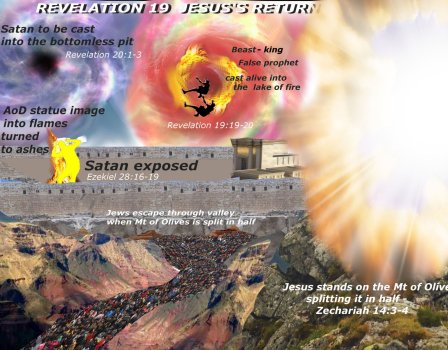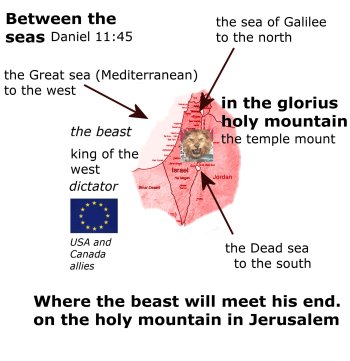Of course there are no sacrifices for sin in the New Testament sanctuary of God. The abomination of desolation placed in the 2nd temple by Antiochus IV Epiphanes is not the same temple - it's a biblical type. And though you desperately try to pretend that you do not understand the difference between a biblical type and its antitype, your argument nevertheless fails dismally - because here is the context of the Olivet Discourse:
LUKE'S GOSPEL vs. MATTHEW'S GOSPEL Below is a comparison of Luke's gospel with Matthew's regarding the location of Jesus at the time He s...

zaoislife.blogspot.com
And here are the rest of the biblical facts that you cannot escape, though you desperately try to:
"Let not anyone deceive you by any means. For the Day of Christ shall not come unless there first comes the apostasy, and the man of sin shall be revealed, the son of perdition, who opposes and exalts himself above all that is called God, or that is worshiped, so that he sits as God in the temple [naós] of God, setting himself forth, that he is God." -- 2 Thessalonians 2:3-4.
The
gospels use the word
naos in reference to the sanctuary of God
in the hieron - the physical temple structure in Jerusalem -
until the verses telling about the tearing of the veil - but not after that.
ἱερόν hierón (hee-er-on'):
[Strongs Greek Dictionary] 02411 (English: Temple):
neuter of 2413; a sacred place, i.e.
the entire precincts, whereas 3485 [naós] denotes the central sanctuary itself (of the Temple in Jerusalem, or elsewhere).
The New Testament only uses the word
naos in reference to the bodies of saints as the temple (naos) of God, the church as the temple (naos) of God, and the heavenly temple in the Revelation
after the verses telling of the tearing of the veil.
The
naos is the holy place where the man of sin / son of perdition will appear, calling himself God and rising from out of the lawlessness (the lawlessness that Jesus told us will accompany the time of the end).
Paul called that tabernacle
the naos - which in the New Testament always refers to the sanctuary of God, and is the word Paul
always only used in reference to the bodies of saints and the church as the tabernacle of God (rather than the word
hieron which he used in reference to
the physical temple in Jerusalem).
After the verses talking about the tearing of the veil in the sanctuary (naos) of God which was contained in the hieron (the physical temple structure)
the first time the word is used again in reference to the sanctuary of God is in Acts, where the apostle states that God does not dwell in a sanctuary (naos) made with (human) hands.
There will be no removal of the daily sacrifice again because that was done in the 2nd temple by Antiochus IV Epiphanes, and there is no daily sacrifice in the sanctuary of God today - but there will appear an idol in the naos - New Testament temple - the man of sin himself.
The abomination of desolation placed in the holy place (which the Greek would refer to as the naos) of the 2nd temple
did not result in the destruction of either the temple or the city - after Antiochus IV was ousted
the temple was cleansed and rededicated to God.
The New Testament Temple
cannot be destroyed bu it can be defiled- and it will be.
"And what agreement does a temple [naós] of God have with idols? For you are the temple [naós] of the living God, as God has said, "I will dwell in them and walk among them; and I will be their God, and they shall be My people." 2 Corinthians 6:16.
"Do you not know that you are a temple [naós] of God, and that the Spirit of God dwells in you? If anyone defiles the temple [naós] of God, God shall destroy him. For the temple of God is holy, which you are." -- 1 Corinthians 3:16-17.
"Let not anyone deceive you by any means. For the Day of Christ shall not come unless there first comes the apostasy, and the man of sin shall be revealed, the son of perdition, who opposes and exalts himself above all that is called God, or that is worshiped, so that he sits as God in the temple [naós] of God, setting himself forth, that he is God." -- 2 Thessalonians 2:3-4.
THE HOLY PLACE OF THE OLD COVENANT / TESTAMENT (Holy Place and Most Holy Place of the Old Covenant / Testament) THE HOLY PLACE OF THE NEW CO...

zaoislife.blogspot.com
================================= "'Abomination of Desolation' is a phrase from the Book of Daniel describing the pagan sacrifices with whic...

zaoislife.blogspot.com
So Jesus told them to run when they see the man of sin appear in the New Testament Temple after rising out of the lawlessness in it (that Jesus told us in Matthew 24:9-14 will accompany the time of the end
in the church).
Therefore the saints in Judea must run when they see it happening in the church/es. Because armies will gather once again against Jerusalem.
THE PECULIARITY OF MANY CHRISTIANS (BUT NOT ALL)
For some reason only God knows the full answer to, though there are many millions of people in the world who speak English, and even more who
can speak English, only a very small minority of them do not understand that the word
therefore in Matthew 24:15 links what
Matthew records Jesus saying about the abomination of desolation to what Jesus had just said about the tribulation of the saints at the end of the age - and though it be rightfully laughable to all the others, that tiny minority happen to all be Christians - making
all Christians be laughed at by all the other millions of people who either speak English or can speak English.
Those Christians who refuse to understand that the word
therefore that Matthew used, links what
Matthew recorded Jesus saying about the abomination of desolation to what He had just said about the tribulation of the saints at the end of the age, do so because they try to assert that
Matthew was writing a
commentary on what
Luke recorded Jesus saying about
the wrath of God coming upon
Jerusalem,
and they somehow manage to do this despite the fact that
Matthew was an eyewitness writing his
own record of all the things that Jesus said on the Mount of Olives,
Mark was writing what
Peter related, and
Luke was recording what who knows how many eyewitnesses were relating about
all the things Jesus said on the Mount of Olives -
and in Luke's gospel he frequently has Jesus saying the exact same things about the end of the age and His return
while still on His way to Jerusalem that
Matthew has Jesus saying
on the Mount of Olives.
Only because it's convenient to keep their minds and their understanding enslaved to their own chosen eschatology do many Christians refuse to acknowledge the meaning of the word
therefore in Matthew 24:15, and to insist on making
Luke's record a
commentary of what
Matthew and
Mark recorded,
Matthew a commentary of what
Mark and
Luke recorded, etc.









